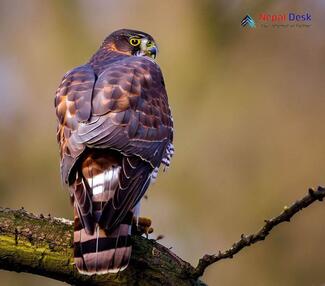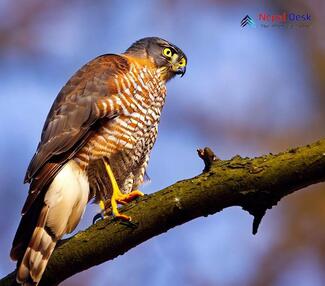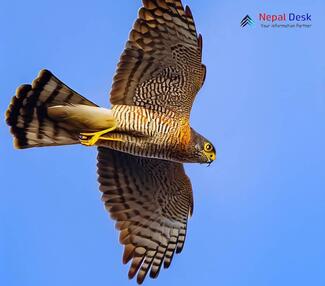With piercing red eyes scanning the forest depths, the Eurasian sparrowhawk embodies the intense focus of a stealthy woodland predator. Its very Latin name Accipiter nisus translates loosely to “swift hawk hunter” - an apt label for a raptor boasting superb aerial prowess in navigating dense understory thickets.
The Eurasian sparrowhawk belongs squarely alongside its close cousins in the Accipiter genus that have mastered the art of pursuing agile bird prey through tight spaces.
Eurasian sparrowhawks are classified within Accipitridae, the diurnal bird of prey family encompassing hawks, eagles, kites, and more. Genetically, they boast a typical raptor diploid chromosome number of 2n=80 and a sizable 1.4 billion base pair genome. This places them firmly amidst fellow short-winged, bird-hunting forest hawks of the Accipiter clan that share key aerodynamic and physiological gifts suited to woodland life.
Eurasian sparrowhawks belong to the Order Accipitriformes, Family Accipitridae, Genus Accipiter, and species Accipiter nisus.
Molecular analyses indicate Eurasian sparrowhawks cluster tightly with other Accipiter hawk species in a genetic lineage based on inherited skillsets best adapted to forest ecosystems where prey grows plentiful but capture comes challenging.
In essence, the Eurasian sparrowhawk’s taxonomic and genetic heritage equips it expertly for its ecological niche — dashing through the trees to snatch oblivious songbirds rapidly detected by sharp vision, and delivering them to hungry young. The ancestral interplay between habitat, physiology, and hunting strategy is spelled out in the sparrowhawk’s scientific classification and DNA.
Flying Behaviour
In the forests of Nepal, Eurasian sparrowhawks display a range of impressive aerial talents. They typically cruise just below the canopy level, darting through small gaps in the foliage at speeds of up to 60 kilometers per hour. When in pursuit of prey, these agile predators can weave through the tightest of spaces at astonishing angles.
During routine flights used for hunting or migration, Eurasian sparrowhawks tend to fly relatively low to the ground, ranging from just a few meters up to around 100 meters in elevation. However, during courtship displays or territorial boundary patrols, they may soar to heights approaching 1,000 meters. The average continuous flight duration for Eurasian sparrowhawks is estimated between 60 to 90 minutes in length.
Given modest body sizes, these hawks are still capable of astounding endurance flights for small raptors. One female Eurasian sparrowhawk tagged in Scotland covered an impressive 4,751 kilometers throughout a 224-day migration journey. That entails flying distances of up to 500 kilometers nonstop over bodies of water like the Sahara Desert or Mediterranean Sea.
So while they disappear unnoticed into Nepal's forests much of the time, Eurasian sparrowhawks transform into vigorous aerial masters when taking to the skies. With forceful wing beats interspersed by graceful glides, they reveal superb speed, agility, and resilience in flight. No doubt their expansive flying abilities aid such a small predator in capturing its prey.
Ecological Importance
As predators, Eurasian sparrowhawks help control populations of small birds and mammals that could otherwise become overabundant. Their hunting prowess helps stabilize the forest ecosystem by ensuring no one prey species dominates. This raptor mainly feeds on tree-dwelling species such as tits, finches, nuthatches, woodpeckers, doves, and thrushes.
In the process of chasing and catching its prey, the Eurasian sparrowhawk also stirs up other animal activity. Other predators like martens, wild felines, and snakes may take advantage of birds and mammals flushed out by the sparrowhawk into more vulnerable positions. This creates a cascade effect that ripples through the whole food web.
Once Eurasian sparrowhawks have fed, leftover feathers and bones provide nutritional subsidies back into the soil and plant growth. As these remnants decompose, the release of carbon, nitrogen, and phosphorus enriches the forest floor. This fuels microorganisms, fungi, and plants that form the foundation of the forest ecosystem.
So while the Eurasian sparrowhawk is just one small raptor species, its role as an agile bird hunter that stirs up prey activity has resounding positive impacts on the biodiversity and health of Nepal’s woodland ecosystems. Its existence as a key predator helps balance populations, energy flow, and nutrient cycling from trees down to topsoil layers.
Identification
For those new to bird watching in Nepal's forests, the Eurasian sparrowhawk can often slip by unnoticed. But with a few helpful identification tips, even novice observers can learn to recognize this small raptor:
Size and Proportions
Eurasian sparrowhawks measure 25-36cm in length with wingspans ranging from 58-74cm. They have short broad wings relative to the body and a long squared-off tail extending behind. Females tend to be up to 25% larger than males.
Color Patterns
Adult Eurasian sparrowhawks have dark slate-grey upperparts with orange-barred underparts. Their breasts feature fine rufous streaks transitioning to barring on the belly. The long tail sports 4-5 dark bands. Yellow cere and feet; red eyes.
Cooperative Hunting
Watch for Eurasian sparrowhawks hunting in pairs or family groups, working cooperatively to flush and ambush prey. Often one bird scares up prey allowing another hawk positioned nearby to capture it mid-flight in its talons.
Distinctive Flight Style
In flight, Eurasian sparrowhawks exhibit fast wing beats with short glides, perfectly suited for maneuvering deftly through dense forests. Plus that long tail allows for tight turns and sudden changes of direction.
Spotting a 25-36cm raptor flashing slate-grey, orange, and barred rufous plumage between the forest trees, possibly hunting alongside another, one can confidently identify an impressive Eurasian sparrowhawk on the prowl!
Nesting Habits
The Eurasian sparrowhawk builds an impressively large nesting platform high up in mature forest trees in Nepal. They favor tall oaks, pines, or beeches around 10-20 meters off the ground, often choosing trees on forest edges near clearings. This allows for easy departure and landing access.
Their bulky nest starts with a base of twigs, sticks, and coarse woody debris. Both the male and female gather materials, but the female takes the lead in interweaving a tidy cup-shaped structure up to 60 cm across. The inner lining features fine soft grasses, pine needles, and feathers for insulation.
Eurasian sparrowhawks exhibit nest site fidelity, returning to refurbish and reuse the same treetop nest for subsequent years of breeding. An existing crow or squirrel drey often provides the initial foundation for added layers.
While incubating eggs or brooding hatchlings, the female remains tightly perched within the inner cup of the massive nest. Her slate gray and rufous barred plumage allows her to blend into the piles of twigs and needles when viewed from below. The male frequently returns with food, allowing their camouflaged eggs and chicks to develop high above safe from predators.
So through the dedicated nest construction and reuse by the adult pair and protective brooding behaviors of the female, Eurasian sparrowhawk treetop nests provide safe nurturing havens each spring in Nepal's forests.
Breeding Behaviour
Courtship Displays
In early spring, male Eurasian sparrowhawks perform dramatic aerial displays to attract females. These complex rollercoaster flights showcase the male's health and flying agility. Dives and ascents transition sharply into smooth glides and dips while vocalizing loud "kiu-kiu" mating calls. If suitably impressed, the female invites pairing by crouching forward with wings upraised.
Parenting Dynamics
Once bonded, the mated Eurasian sparrowhawks share parental duties. The female lays and incubates the eggs while the male provides food for his incubating partner. After hatching, only the female broods the young nestlings while both parents intensify hunting to satisfy the chicks’ ravenous appetites.
Mobbing Potential Threats
Adult Eurasian sparrowhawks vigorously chase potential nest predators like martens, snakes, or corvids. The nesting hawks give harsh alarm calls rushing at the intruder in flight or diving in attacks, sometimes joined by small mobbing birds. Most threats wisely choose to avoid an aggressive parent sparrowhawk!
By coordinating mating rituals, supply runs, and nest protection efforts, Eurasian sparrowhawk pairs ensure their breeding efforts and vulnerable chicks survive amongst Nepal’s bustling forest ecosystems. Their collaborative vigilance also serves to teach the next generation key survival skills. Soon the fledglings themselves will perform aerial displays and build intricate nests continuing the sparrowhawks’ legacy as Nepal's forest stewards.
Feeding Habit
Diet
Eurasian sparrowhawks mainly prey on small birds like finches, tits, nuthatches & thrushes captured mid-flight. They also opportunistically hunt small mammals (voles, mice), amphibians, reptiles, and large insects. Accipiter hawks like the sparrowhawk have shorter wings suited for greater maneuverability when chasing prey through dense woods.
Hunting Habits
Eurasian sparrowhawks often launch surprise attacks utilizing cover, speed & their camouflaged plumage to ambush oblivious quarry. Or one adult flushes prey from foliage allowing the partner to intercept it. They can snatch a victim midair with sharp nails, carrying it to a secluded perch for dismantling.
Feeding Dynamics
When provisioning for incubating mates or begging nestlings, male Eurasian sparrowhawks perform most hunting duties. They pass food midair to the female or carry it back to the nest as the family’s needs intensify. Nestlings drool “reward droplets” stimulating the male to keep up supply runs of plucked, bite-sized pieces.
Social Structure
Eurasian sparrowhawks are believed solitary outside the breeding season. However, some studies show nonbreeding juvenile hawks aggregating where prey is abundant, possibly learning group hunting techniques from elders that carry over into mated pairs’ cooperative tactics.
So whether independently ambushing prey or coordinating family food provisioning, Eurasian sparrowhawks reveal clever survival strategies for securing the nutrition needed to sustain Nepal’s next generation of elite forest hunters!
Migration
Eurasian sparrowhawks that breed in Nepal's forests are considered partial migrant residents. Adults tend to remain in the region year-round on established territories. However, when prey becomes scarce in winter, the hawks may migrate variable distances towards more abundant resources before returning the next spring.
Navigation
Remarkably, young fledgling Eurasian sparrowhawks completely alone can navigate enormous distances of over 5,000 km on their first fall migration journeys to wintering grounds across Asia and eastern Africa. Their magnetic compass sense and mental map imprinted while still in the nest guide them unerringly to suitable habitats.
Pair Bonding
Eurasian sparrowhawks form close breeding bonds, often reuniting year after year. One pair tracked by researchers remained together over 16 seasons spanning two decades! Partners use aerial displays, bonding rituals, and synchronized territorial patrols to continually reinforce their steadfast pair commitment across years, migration cycles, and parenting new broods.
So from the fledglings’ solo odysseys to the enduring loyalty between seasoned mates, Eurasian sparrowhawks demonstrate profound instincts guiding their travel resilience and relationship devotion as they move across continents and seasons together. Truly symbols of the spirit and freedom their forest home provides!
Migration
Every year, Eurasian sparrowhawks that nest in Nepal's forests must decide whether to embark on migration based on resource availability. While some adult hawks remain on established territories year-round, others opt to migrate variable distances when winter prey becomes scarce.
Migrating adults tend to move only as far as required to find adequate food and shelter within Asia. Banded Eurasian sparrowhawks from Nepal have turned up in northern India, Bangladesh, Myanmar, southern China, and even as far northwest as Russia!
Typically the sparrowhawks follow mountain ridges and coastlines that provide plentiful cover during these journeys spanning hundreds to thousands of kilometers.
Meanwhile, fledgling juvenile hawks migrating alone for the first time tackle immensely more ambitious overseas crossings. Some venture from Nepal down to eastern Africa's plains! Equipped with inborn navigation systems attuned to the earth's magnetic fields and star patterns, these young sparrowhawks can fly astonishing distances of 5,000+ kilometers over oceans and deserts guided by their mental imprinting. It remains unclear if they traverse continuously or island hop. Regardless, the solo feats performed annually by mere months-old Eurasian sparrowhawks rank among the animal kingdom’s most incredible navigation stories.
Come springtime, the far-flying adults' inversion course to reunite with prior mates back in Nepal’s forests. And if the hardy juveniles survive their maiden treks, they too will one day return as savvy migrants - and future nesting birds giving the next generation wings to continue the epic cycle.
Habitat
Range
Eurasian sparrowhawks occupy forested areas across much of Nepal up to around 3,000 meter elevations. Their core breeding and hunting grounds center in the mid-hills region, but may also utilize lower tropical forests or higher mountain woodlands depending on seasonal prey movements.
Key Habitats
Prime sparrowhawk nesting habitat includes mature oak, pine, rhododendron, and mixed deciduous forests with tall old-growth trees and clearings. For wintering range, they require thick cover like dense riverine forests lined with shrubs and grasslands providing ample small bird and mammal populations.
Birding Hotspots
Excellent sites to spot Eurasian sparrowhawks include Shivapuri Nagarjun National Park near Kathmandu, the woodlands of Chitwan National Park, and temperate forest trails around Namche Bazaar in Sagarmatha National Park. Also, try Ramsar wetland sites like Koshi Tappu Wildlife Reserve or forested pockets along the Annapurna Circuit trek.
Watch for these swift woodland raptors bolting between trees, constructing huge nests, or displaying spirited aerial courtships. And listen for their "ki-ki-ki" alarm calls revealing a watchful parent sparrowhawk guarding their treetop nursery domain! By exploring Nepal's protected native forests, one can truly appreciate the vital habitat these raptors depend on.
Global Range
Origins & Spread
The Eurasian sparrowhawk likely originated in forested areas of central Siberia during the Pleistocene glacial period. From this ancestral range core, sparrowhawks later expanded their territory south and west into Europe and Asia as forests advanced in warmer post-glacial periods. Today remnants of this historic northerly distribution remain with Eurasian sparrowhawks breeding across the taiga forests of Russia.
Current Breeding Range
Eurasian sparrowhawks currently occupy a vast breeding range spanning temperate and subtropical woodlands from Europe clear across central Asia to Sakhalin Island north of Japan. Within their western limits, breeding grounds reach north into Scotland and Scandinavia and as far south as Spain, Italy, and Greece in Europe. Their range also extends south through the Middle East and the Himalayas including all forested regions of Nepal.
Disjunct Wintering Populations
Variable winter migrations transport Eurasian sparrowhawks well beyond core breeding latitudes. Northernmost populations like in Russia migrate south and west over winter. Himalayan hawks funnel down the Indian peninsula or fly remarkable distances to eastern Africa. This seasonal flux leads to a widespread complex wintering distribution in Europe, Asia, India, and Africa - a dynamic legacy of the sparrowhawk's deep evolutionary roots to nimbly pioneer pathways to abundance.
Differentiator
Sexual Dimorphism
Female Eurasian sparrowhawks average 25% larger than males. They weigh almost double a male's petite 230g frame at 400g. Females also sport more heavily barred underparts whereas the male's finer streaking transitions cleanly between breast and belly zones. Experienced birders can distinguish gender in flight through these subtle size and plumage differences.
Similar Species
The shikra is a similar small Asian accipiter hawk with more rounded wings and a fan-shaped longer tail. Shikras occupy more open woodland and urban areas rather than deep mature forest habitats. Besra sparrowhawks boast distinctive yellow legs and fine barring even on the breast and head; they prefer more tropical ranges. Larger goshawks exhibit bold white supercilium beyond the red eyes and bluish-grey dorsal tones.
Confusion Risks
Novice birders occasionally misidentify Eurasian sparrowhawks in flight as other small raptors like Eurasian kestrels (longer pointed wings, hover-hunting) or even crows (larger head size relative to body bulk, no distinct tail bands). Carefully noting field marks and flight mannerisms prevents such mix-ups.
So paying attention to subtle variations in size, wings, tail, and plumage remains key to differentiating Nepal's forest-dwelling Eurasian sparrowhawks from lookalikes as they zip amongst the trees.
Ideal Seasons
The breeding season from March to July provides good sighting opportunities in Nepal as pairs announce territory claims and construct conspicuous nests. Males also display aerial courtship flights. The fall migration period similarly boosts activity. Otherwise, Eurasian sparrowhawks remain fairly elusive all winter.
Spotting Techniques
Scan openings and gaps carefully within mature, old-growth woodland habitats. Look for bulky twig nest structures high up on sturdy oaks or pines. Target forest edges near meadows and listen for "ki-ki" alarm calls. Inspect clearings for plucking stations with prey remains that serve as feeding perches and watch flyover zones between trees to glimpse speeding adults. Seeking out nests and activity hubs takes patience but offers the best chance to observe these secretive forest hawks!
So while Eurasian sparrowhawks blend into Nepal’s vibrant forests remarkably well across most months, fine-tuning location specs and techniques to key breeding and migration seasons promises the greatest likelihood of encountering one of these athletic aerial masters.
IUCN Conservation Status
Eurasian sparrowhawks are listed as a species of Least Concern on the IUCN Red List thanks to their large range extent and healthy populations, especially across Europe. However, their specific status within Nepal has not been well quantified. Forest habitat protection aids continued success throughout their Himalayan breeding distribution.




